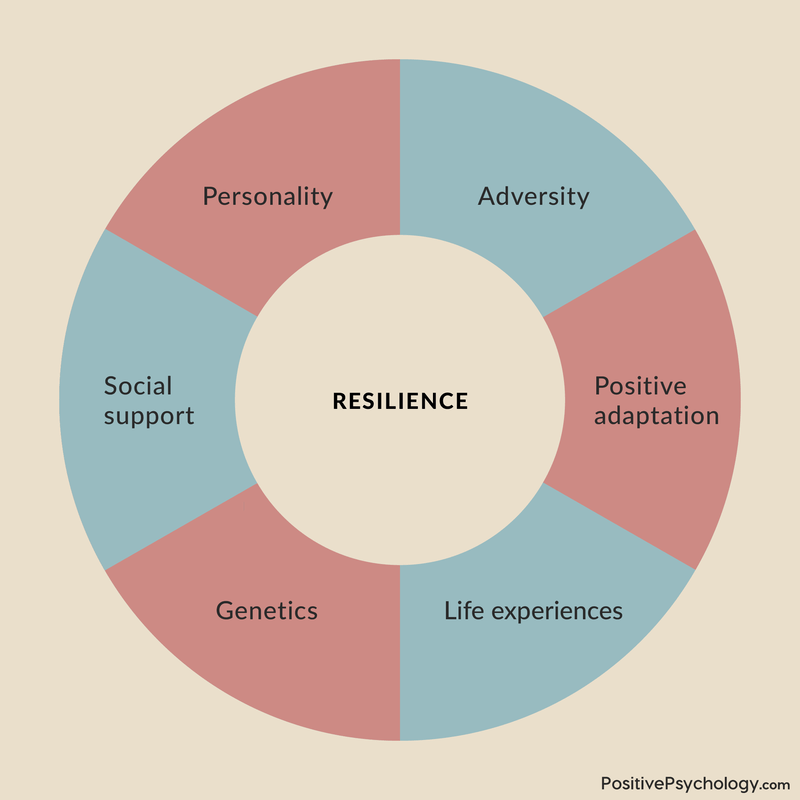Key Insights
- Resilience is the ability to bounce back from adversity with flexibility & strength, maintaining wellbeing despite challenges.
- Key components of resilience include emotional regulation, optimism & a strong support network, all of which can be developed over time.
- Building resilience involves cultivating coping strategies, fostering positive relationships & practicing self-care to enhance life satisfaction & adaptability.
Resilience is equally intriguing and hard to define.
Why does one person embrace the tough times while another crumbles?
Research recognizes that many factors come into play regarding how resilient we are, including our traits, environmental factors, and a learned capacity associated with experience (Pemberton, 2015).
While our ability to bounce back from the obstacles that life throws at us is, without a doubt, an essential aspect of resilience, it can also surface in other equally adaptive ways that challenge our understanding of the concept (Neenan, 2018).
In this article, we not only answer what resilience is, but dig deeper into this complex yet essential concept and explore how resilience theory can improve our understanding and inform our practices with clients.
Before you continue, we thought you might like to download our three Resilience Exercises for free. These engaging, science-based exercises will help you effectively deal with difficult circumstances and give you the tools to improve the resilience of your clients, students, or employees.
This Article Contains
- What Is Resilience, and Why Is It Important?
- Being Resilient: Its Meaning in Psychology
- 6 Signs of Resilience in Life
- What Are the 10 Resilience Skills?
- How to Build Resilience
- What Is an Example of Resilience?
- Related PositivePsychology.com Resources
- A Take-Home Message
- Frequently Asked Questions
- References
What Is Resilience, and Why Is It Important?
People can survive the most challenging ordeals—some even thrive. And yet, they may be unaware or unclear exactly how they got through the challenges they faced (Neenan, 2018).
Inner resilience is an important resource that appears to be the secret to success in the outer world and the basis of good mental health (Neenan, 2018).
The suggestion that resilience is simply being able to bounce back most likely comes from its use in the physical sciences. A resilient material can return to its original state after being bent or stretched—often dramatically. Just think of a bridge spanning a wide river, maintaining its integrity despite twisting in the wind, or a small flower growing through concrete (Pemberton, 2015).
Similarly, resilience in the human context has been described as the “capacity to remain flexible in our thoughts, feelings, and behaviors when faced by life disruption, or extended periods of pressure, so that we emerge from difficulty stronger, wiser, and more able” (Pemberton, 2015, p. 2).
Being Resilient: Its Meaning in Psychology
 The resilient individual often does more than simply bounce back.
The resilient individual often does more than simply bounce back.Following a significant event, such as the death of a loved one or an unexpectedly bad medical diagnosis, even the most resilient person is unlikely to return to the path they were on—or at least remain unchanged.
Instead, psychology recognizes that resilient individuals going through significant life events do not always recover effortlessly; they often find a new path. Even when knocked by what has happened, the darkest times still typically lead to growth, including (Neenan, 2018):
- A new or revised self-image
Resilient people become aware of unexpected abilities as they rise to each new challenge. - Enriched and clarified relationships
During difficult times, they recognize the friends who remain and offer support and those who no longer return calls or are toxic or draining and prioritize positive relationships. - Altered priorities
A new and possibly more focused perspective can remove what is unimportant and clarify and motivate meaningful values, life goals, and priorities.
A renewed purpose can also strengthen the resolve of those who are already resilient. “Studies have found that having a clear and valued purpose, and committing fully to a mission, can markedly strengthen one’s resilience” (Southwick & Charney, 2018, p. 251).
What is psychological resilience?
Over time, stress can have a damaging impact on our psychological, emotional, and physical wellbeing. Psychological resilience can protect individuals from its effects and boost their ability to regain a sense of control in their lives (Southwick & Charney, 2018).
While there are many definitions of resilience, psychologists typically agree that it is a multi-fold concept, made up of both the capacity to handle difficult times and our ability to respond flexibly. Some researchers go further, identifying the following three factors as essential to resilience (Boniwell & Tunariu, 2019):
- Recovery
Returning to normality or the pre-stressor degree of functioning - Resistance
Limited or no signs of disturbance following the stressor - Reconfiguration
Returning to a different homeostasis and finding new stability according to the change in circumstances
Unlike recovery or resistance, reconfiguration is an essential part of the process of transformation the individual experiences when a return to their original path is difficult or unthinkable (Boniwell & Tunariu, 2019).
6 Signs of Resilience in Life
Resilience research recognizes each of the following as both facilitators and indicators of resilience in individuals (Boniwell & Tunariu, 2019; Neenan, 2018):
- Reframing
Looking at a problem or situation from a different, more helpful perspective can help the individual cope. - Using the power of positive emotions
Such feelings broaden our thinking and enable us to come up with alternative strategies for solving problems more creatively. They can also improve our sense of belonging, helping us bond with supportive individuals and groups and boosting our sense of accomplishment and ideas of purposeful living. - Participating in physical activities
Being more active can help manage and reduce the impact of stress along with improving confidence and self-esteem. - Ongoing active engagement in trusted social networks
Social support from trusted friends, colleagues, and family members can leave us feeling less isolated and help us adopt a better perspective regarding what is happening. - Identifying and using signature strengths
Engaging our strengths can leave us feeling more authentic, increasing our sense of meaning and control when we take on new challenges or overcome adversity. - Optimism regarding the future
Looking toward the future with optimism can help us recognize that setbacks are usually temporary and surmountable, helping us feel more hopeful and positive about what lies ahead.
The above are all valuable signs to watch out for with clients to assess their readiness and ability to adopt a more resilient outlook on life.
What Are the 10 Resilience Skills?
 There is no single skill that supports resilience in individuals.
There is no single skill that supports resilience in individuals.Instead, it is the development of a resilient mindset, a set of tools and skills to manage challenging times, and the creation of a supportive and growth-minded environment (Boniwell & Tunariu, 2019; Neenan, 2018).
The following 10 resilience skills can be shared and developed with clients to help them become more resilient (Duckworth, 2016; Pemberton, 2015; Southwick & Charney, 2018):
- Problem-solving
Problem-solving is the ability to identify, analyze, and break down problems and generate potential solutions. The most effective ones are then chosen and implemented. - Goal setting
Goal setting involves setting well-defined and achievable goals and then taking small steps toward achieving them. Working toward goals builds confidence and a sense of accomplishment, which can contribute to resilience. - Effective communication
This involves learning to express needs and feelings clearly and assertively and actively listening to others. - Emotional regulation and stress management
Since emotional regulation is the ability to control and manage one’s emotions in a healthy way (Gross, 1998), specific approaches can manage emotions and stress.
These include practicing relaxation techniques (including mindfulness and deep breathing), cognitively reframing challenges and pressures as opportunities, and engaging in physical activity. - Building a social support network
This involves developing and maintaining a solid network of supportive relationships with friends, family, and other trusted individuals. - Practicing self-care
Self-care activities should promote physical, emotional, and mental wellbeing, including getting adequate sleep, eating a healthy diet, exercising regularly, and finding time for relaxation and hobbies. - Developing meaning and purpose in life
This involves finding purpose and meaning in life, whether in work, relationships, or other personally fulfilling activities. - Adopting a positive outlook
Cultivating a positive outlook and a growth mindset might include practicing gratitude, focusing on the good things in life, reframing negative thoughts, and seeing setbacks as opportunities for learning and growth, while maintaining a hopeful outlook. - Improving self-awareness
Developing self-awareness includes learning to understand thoughts, emotions, and behaviors to improve responses to stress and adversity and recognizing when to seek support. - Adopting effective coping strategies
Healthy coping mechanisms might include positive self-talk, visualization, exercise, goal focus, social support, mindfulness, and relaxation techniques.
Resilient individuals are typically more adaptable, open to new changes and experiences, and adopt a healthy perspective when they see setbacks as opportunities for learning (Neenan, 2018). They also tend to be effective at distinguishing between what they can and cannot control during times of adversity.
Over the last few decades, comprehensive research into resilience has found several protective and promotive factors that make some individuals more resilient. They include self-regulation skills, effective schooling, good parenting, genetics, mindset, and community resources (Lopez et al., 2021).
The most resilient people are likely to have benefited from a combination of these basic human protective systems.
It is worth noting that resilience is not a fixed trait, but can be developed and grown over time. Let’s look at how to improve resilience.
ResilienceResilience is a sought-after trait we can all benefit from, but what does resilience really mean?
How do we show resilience, and how do we recognize resilience in others?
The two key components of resilience are adversity and positive adaptation. Resilience is often referred to as the ability to ‘bounce back’ in the face of adversity. Without adversity, we are not challenged, and therefore not required to adapt.
Critically, the ‘bounce back’ is positive, often leading to the establishment or reinforcement of our inner strengths. The cognitive and emotional tools we develop when we adapt to adversity equip us to deal with what we may face in the future.
A wide range of factors influence resilience. There is debate over the extent of the impact of each factor, although it is largely agreed that genetics, personality, social support, and life experience all play a role (Fletcher & Sarkar, 2013).
Thinking about these core concepts allows us to reflect on situations where we have had the opportunity to develop resilience and identify times when we have been more or less resilient. Understanding why some people tend to bounce back more effectively than others in the face of adversity is critical for supporting those going through challenging times.

How to Build Resilience
 Positive psychology offers proven interventions and approaches for benefiting individuals’ mental wellbeing and resilience.
Positive psychology offers proven interventions and approaches for benefiting individuals’ mental wellbeing and resilience.While there are many, we can group several of these approaches as follows (Boniwell & Tunariu, 2019; Shapiro, 2020).
Positive psychology interventions
Active interventions
Exercise, particularly high-intensity exercise, positively affects psychological and physical wellness and reduces the impact of stress.
Similarly, reducing unhealthy behaviors, such as smoking or drinking too much alcohol, is equally beneficial. Exercise can provide a foundation for coping with stress and adversity. As a means to manage stress, it improves your ability to be resilient.
Calming interventions
Mindfulness, deep breathing, and relaxed activities, such as mindful walking or mindful yoga, are particularly effective at managing existing and future life challenges.
Acceptance and Commitment Therapy combines techniques to teach clients how to accept difficult thoughts, feelings, and sensations without reacting in unhelpful or unhealthy ways.
Identity interventions
Recognizing our core selves through understanding and using our signature strengths more frequently helps us perform at our best, feel energized, and experience control during difficult times.
Online tests such as the Values in Action test or the Clifton Strengths survey can help us become more resilient and flourish in our personal and working lives.
Optimizing interventions
Finding ways to realize who we want to be can help us live more fulfilling, meaningful lives in line with our core values, protecting us from stress and maintaining a more resilient outlook.
Focusing on hope and optimism and setting and working toward goals to build psychological capital are powerful approaches.




